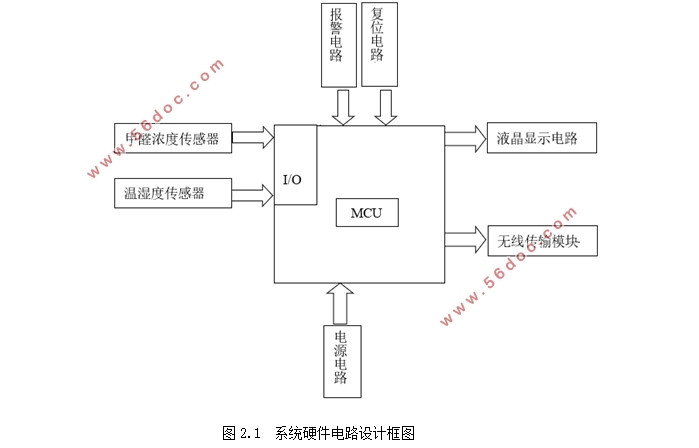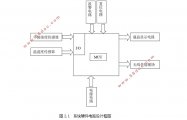室内环境无线监测系统的设计(任务书,开题报告,论文15000字)
摘要
人们对室内环境的质量有两方面要求,舒适且安全,前者即温度和湿度,后者即有害气体浓度如甲醛、甲苯等。这两个方面对人员密集且空间有限的幼儿园教室,养老院房间等尤为关键。
鉴于幼儿园内儿童居多且人员密集,较容易因为空气质量的问题而造成人身健康问题,本次课题对幼儿园室内空气质量做无线监测。依据GB/T18883-2002 室内空气质量标准,监测室内的温湿度和甲醛浓度,采用相关传感器采集数据,传入到主控芯片(MCU)中,分析处理后通过LCD1602屏显示实时数据,超标时可报警,最后我们可以手动控制处理好的数据通过GPRS模块以TEXT短信形式发送到家长手机端,以便家长可以了解幼儿园的环境情况。
系统实现时,先proteus电路仿真,接着搭建并测试各模块电路,然后keil程序编译调试,最后系统整体调试和测试,结果表明,系统达到了预期要求。
关键词:单片机 传感器 GPRS
Design of Wireless Monitoring System for Indoor Envoirment
Astract
There are two requirements for indoor environment quality, comfortable and safe, the former is temperature and humidity, the latter is harmful gas concentration such as formaldehyde, toluene and so on. These two aspects are particularly critical for kindergarten classrooms with dense staff and limited space, and nursing home rooms.
In view of the fact that the number of children in kindergartens is large and the number of people is dense, it is easy to cause personal health problems because of the air quality problems. This topic conducts wireless monitoring of the indoor air quality in kindergartens. The monitoring objects are temperature, humidity and formaldehyde concentration. Data are collected by relevant sensors and transmitted to MCU. Real-time data are displayed on LCD1602 screen after analysis and processing. When exceeding the standard, the alarm can be given. Finally, we can manually control the processed data and send it to parents'mobile phone through GPRS module in the form of TEXT short message, so that parents can understand the environment of kindergartens.
According to GB/T18883-2002 indoor air quality standard, this paper collects data for indoor temperature, humidity and formaldehyde concentration, and analyses and processes them. Through multimeter on-off test, Proteus circuit simulation and keil program compilation and debugging, the system achieves the expected functions, which can be displayed in real time through CD1602, over-standard alarm processing, wireless transmission (sending short messages). In the program, the correction and compensation of the collected data are realized to ensure the accuracy.
Key words: single chip ;sensor;GPRS

目录
摘要 I
Astract II
第一章绪论 1
1.1 课题背景、目的及意义 1
1.2 研究现状 2
1.3本文章节安排 4
第二章系统总体设计 5
2.1 系统硬件的总体设计 5
2.2系统软件的总体设计 6
第三章系统硬件电路的设计 7
3.1主控模块的芯片选择和电路设计 7
3.1.1 单片机的选择 7
3.1.2 stc89c52功能引脚简介 7
3.1.3 主控模块的电路设计 9
3.2温湿度传感器模块 10
3.2.1器件选型 10
3.2.2 dht11传感器工作原理 10
3.2.3 温湿度传感器模块电路设计 11
3.3甲醛浓度传感器模块 12
3.3.1 器件选型 12
3.3.2 ZP01工作原理 12
3.3.3 模块电路设计 13
3.4无线传送模块 14
3.4.1 器件选型 14
3.4.2 GPRS SIM600参数 14
3.4.3 模块电路设计 15
3.5液晶显示模块 15
3.6警报模块 17
第四章软件设计 18
4.1温湿度传感器 18
4.1.1 驱动原理 18
4.1.2 部分驱动代码 20
4.2甲醛浓度传感器 21
4.2.1 驱动原理 21
4.2.2 部分驱动代码 23
4.3无线传送模块 24
4.3.1 驱动原理 24
4.3.2部分驱动代码 25
4.4 CD1602显示模块 27
4.4.1 驱动原理 27
4.4.2 部分驱动代码 30
第五章测试过程 32
5.1 测试工具 32
5.2 CD1602测试过程 32
5.3 传感器测试过程 33
5.4 GPRS模块测试过程 36
第六章总结与展望 38
6.1 总结 38
6.2 展望 39
参考文献 40
致谢 41
|



